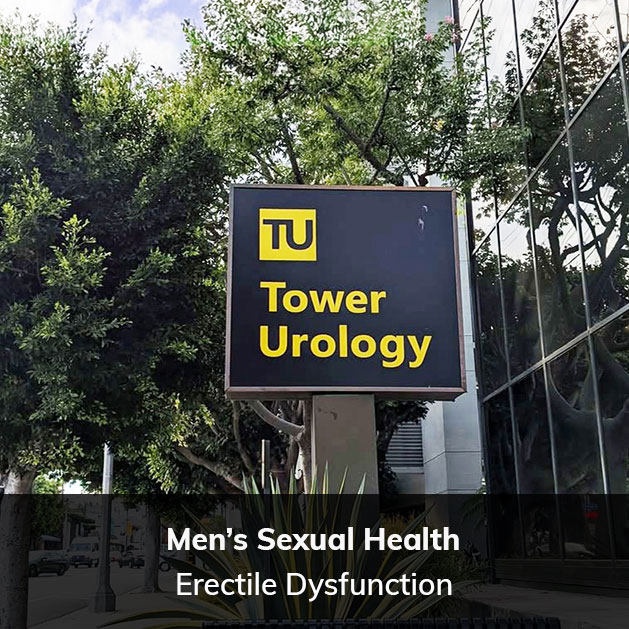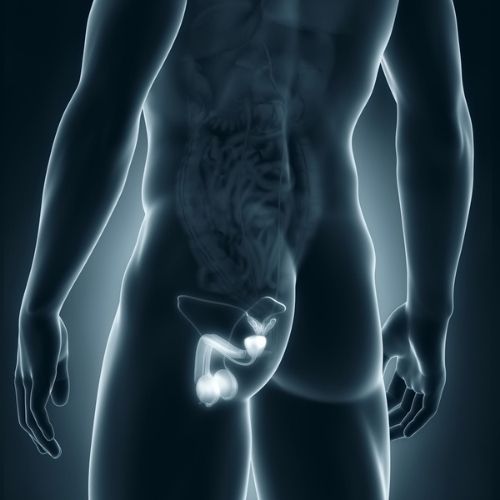What is erectile dysfunction?
Erectile dysfunction (ED), also known as male impotence, is the inability to either attain or maintain an erection of sufficient rigidity to have satisfying intercourse. Since erectile issues are one of the first problems to occur in an unhealthy body, this group of issues is referred to as the body’s “check engine” light.
Erectile dysfunction is relatively common. Approximately 40% of men aged 40 are affected, and nearly 70% are affected at age 70.

What causes an erection to occur?
The main body of the penis is composed of two columns of spongy tissue in the shaft of the penis. These are called the corpus cavernosum. As the blood vessels in the corpus cavernosum fill with blood, an erection is produced.
Natural erections result from highly coordinated neurovascular processes involving the nervous, vascular, and endocrine systems. The erectile process begins with either tactile (touch) or mental stimulation, which triggers the release of neurotransmitters from the brain.
These neurotransmitters cause an increase in the release of nitric oxide (NO) within the corpus cavernosum. NO causes the production of cGMP. This chemical messenger directly affects the dilation (expansion) of arterial smooth muscles. The effect of cGMP in the penis is blood vessel dilation, an increase in blood flow into the penis, and, thus, an erection.
Increased penile expansion during an erection causes increased pressure on other parts of the penis. One of these parts is the bridging veins that are responsible for penile detumescence (loss of an erection). The increased pressure compresses these veins, decreases the outflow of blood from the penis, and keeps the erection rigid.
When sexual stimulation is reduced, a chemical messenger called phosphodiesterase 5 (PDE5) breaks down the cGMP, decreasing blood flow into the penis, reversing the process.
Any health condition that negatively affects these processes can impair erectile function. However, treatment options are available to enhance these processes and improve erectile function.
What are the common causes of erectile dysfunction?
As a comprehensive men’s health clinic, Tower Urology focuses not only on treating erectile dysfunction but also on identifying its causes. Since an erection is a highly coordinated physiological process, it can be affected by a multitude of reasons and medical conditions, including:
- Neurogenic disorders (neuropathy, Multiple Sclerosis, Parkinson’s disease).
- Prescription drugs (SSRIs, beta blockers, alpha-2 agonists, hormone modulators, 5α reductase inhibitors, thiazide diuretics).
- Reduced blood flow to the penis.
- Post-prostate cancer surgery or pelvic surgery.
- Vascular disease.
- Psychological conditions.
- Venous leak (vein leakage).
- Diabetes and other hormonal disorders.
- Pelvic trauma.
- Peyronie’s disease (scarring of erectile tissue).
Why is it important to treat erectile dysfunction?
Male sexual health is an intimate and sensitive topic. Erectile dysfunction can lead to worsening self-esteem, depression, and anxiety, and cause emotional strain on intimate relationships. We at Tower Urology understand the sensitive nature of discussions regarding sexual performance difficulties, and we ensure to treat all men with the proper discretion and respect that they deserve.
One of our healthcare providers will carefully review your medical history to provide you with the necessary medical advice to make an informed decision about how to proceed. Proper treatment can be recommended that may help you return to a satisfying sex life.
What treatment options are available for erectile dysfunction?

Lifestyle changes
The first things to consider are holistic, drug-free options, which include lifestyle changes. Lifestyle changes can contribute not only to improved erectile function but also to overall good health and a better quality of life. Examples of lifestyle changes that could contribute to improved erectile function include:
- Regular exercise.
- Weight loss.
- Decreasing or limiting alcohol consumption.
- Dietary changes to reduce the intake of fat and cholesterol.
- Eliminating the use of tobacco and vaping.
Medication changes
A careful review of your current medications may result in changes, primarily if they are known to cause erectile dysfunction.
Oral medication therapy
Oral medications, such as Viagra, Cialis, Levitra, and Stendra, are all ways to improve penile blood flow by directly dilating blood vessels. They allow the arteries to engorge to produce an erection. As widely used today, they are ineffective for 20-30% of men.
External appliances
Vacuum pump therapy is a non-invasive method for producing an erection. When the pump device is placed over the penis, a vacuum is created, mechanically enhancing blood flow into the penis. A rubber ring is then positioned at the base of the penis to help retain blood, thereby maintaining the erection.
It is essential to note that vacuum pumps should not be prescribed for patients with bleeding disorders, those taking anticoagulants, or individuals with sickle cell disease.
Intraurethral gels
Intraurethral gels require the insertion of a small dose of medication directly into the urethral opening at the end of the penis. This is the same opening where urine (pee) and sperm come out. Since the gel is placed within the urethra, the medication is readily absorbed into the erectile tissue, thereby dilating the blood vessels and enhancing penile blood flow.
Possible side effects include priapism (a sustained erection lasting longer than 4 hours) and a mild burning sensation after application.
Shockwave treatment for ED
Extracorporeal shock wave therapy (ESWT) is a unique new treatment for erectile dysfunction (ED). Unlike other ED treatments, shock wave therapy aims to achieve normal erections without assistance. It can restore natural erectile function by improving penile health and blood flow.
Shock wave therapy utilizes low-intensity, pulsatile sound waves at the cellular level to increase penile neovascularization and stimulate increased blood flow to the penis.
Penile injection therapy
Penile injection therapy is the most effective non-surgical method for treating erectile dysfunction. Typically, it involves a potent three-drug combination injection of phentolamine, alprostadil, and papaverine (Trimix). The injection is administered towards the base of the penis at the lateral aspect.
Once injected, the smooth muscles of the erectile bodies relax, allowing increased blood flow and producing an erection within 3-5 minutes. One possible complication associated with penile injection therapy is priapism (a sustained erection lasting longer than 4 hours); therefore, careful dose adjustments must be managed by a qualified urologist.
Inflatable penile prosthesis
We are often asked, “What is a penile prosthesis?” Simply put, a penile prosthesis is a surgical option in which a prosthetic device is placed into the corpus cavernosum. This causes rigidity during sexual intercourse.
The three forms of penile implants are:
- Semi-rigid prostheses: silicon-covered flexible metal rods are implanted into the corpus cavernosa, providing rigidity for intercourse. These implants remain rigid at all times, so patients must bend the prosthesis straight when they want to engage in sexual activity. Bendable penile implants are mainly offered to patients without the manual dexterity in their hands to activate an inflatable prosthesis.
- Inflatable penile prostheses: two soft silicone tubes are implanted into the penis, along with a small reservoir in the abdomen and a small pump in the scrotum. This has a more natural appearance with erections and is easier for patients to conceal when they are not active.
- Self-contained inflatable implants: this consists of a pair of inflatable tubes inserted into the penis with a pump attached to the end of the implant and a reservoir located in the shaft of the penis.
Why trust Tower Urology for the treatment of erectile dysfunction in Los Angeles?
Tower Urology’s board-certified urological team and erectile dysfunction specialists have been leaders in successfully treating erectile dysfunction for decades, with specialists trained in all aspects of urological care. We are currently accepting new patients.
The Tower Urology’s advantage lies in our unwavering commitment to providing world-class urologic care through advanced technology, personalized treatment plans, and a patient-centered approach. With a reputation for excellence and innovation, we deliver superior outcomes that set us apart as a leader in urologic health.
Tower Urology is a proud affiliate of Cedars-Sinai Medical Center, ranked #1 in California and #2 in the nation by U.S. News & World Report. This partnership reflects our commitment to delivering the highest standard of urologic care with the best urologists in Los Angeles. Our years of experience and access to Cedars-Sinai’s world-class facilities and our exceptional, innovative, and state-of-the-art urological care make Tower Urology a leader in Southern California.
Tower Urology’s ED doctors are conveniently located for patients throughout Southern California and the Los Angeles area, Beverly Hills, Santa Monica, West Los Angeles, West Hollywood, Culver City, Hollywood, Venice, Marina del Rey, and Downtown Los Angeles.
Our services include treatment for erectile dysfunction (ED), low testosterone, male infertility, vasectomy, and vasectomy reversal.
Erectile dysfunction FAQs
Insurance coverage for erectile dysfunction (ED) treatment varies depending on the specific plan and insurance provider.
Yes, erectile dysfunction (ED) can be a sign of an underlying health condition. ED can be related to physical issues like heart disease, diabetes, and high blood pressure or mental health concerns like depression and anxiety.
Sources
Erectile Dysfunction
https://www.mayoclinic.org/diseases-conditions/erectile-dysfunction/symptoms-causes/syc-20355776#:~:text=Physical%20issues%20like%20heart%20disease,also%20interfere%20with%20sexual%20feelings.
































































